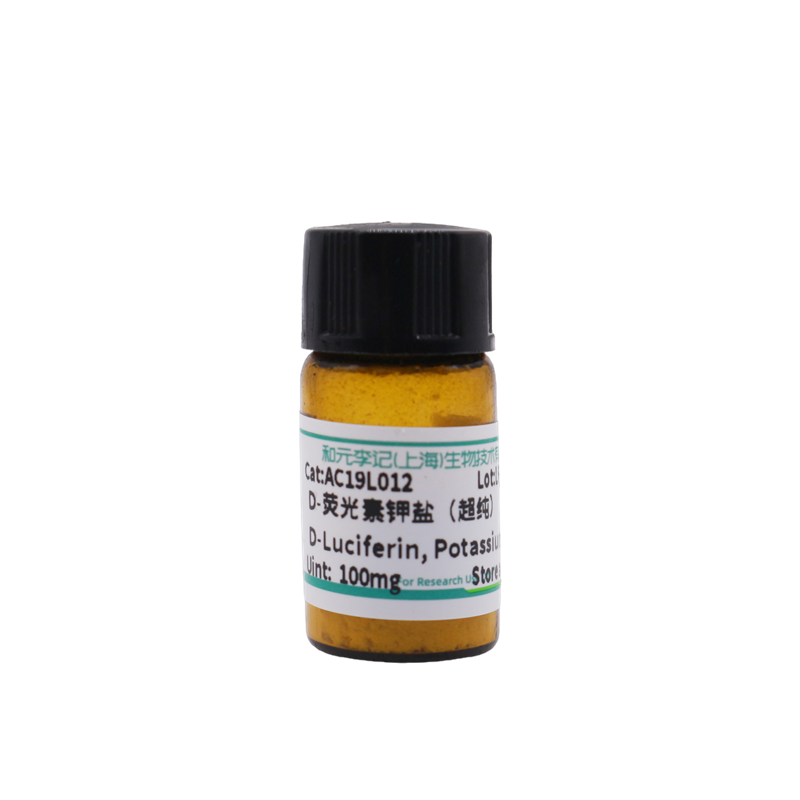Product Description
D-Luciferin Free acid, potassium salt, and sodium salt *UltraPure Grade*D-Luciferin is a commonly used substrate for luciferase and is widely used in the entire field of biotechnology, especially in vivo imaging technology. The mechanism of action is that under the action of ATP and luciferase, luciferin (substrate) can be oxidized and emit light. When there is an excess of fluorescein, the number of generated photons is positively correlated with the concentration of luciferase (see figure below). After transfecting plasmids carrying the luciferase encoding gene (Luc) into cells, they are introduced into research animals such as rats and mice, and then injected with luciferin. Changes in light intensity are detected through bioluminescence imaging technology (BLI), thereby monitoring the disease progression or the therapeutic efficacy of drugs in real time. The influence of ATP on this reaction system can also be utilized to indicate energy or vital signs based on changes in bioluminescence intensity.

D-luciferin is also commonly used for in vitro research, including analysis of luciferase and ATP levels; Reporting gene analysis; High throughput sequencing and various pollution detection. There are currently three product forms on the market, D-fluorescein (free acid), D-fluorescein sodium salt, and D-fluorescein potassium salt. The main difference between these three products lies in their dissolution characteristics. D-fluorescein (free acid) has weak water solubility and buffering system solubility, unless dissolved in weak alkaline solutions such as NaOH and KOH. Dissolved in methanol (10 mg/mL) and DMSO (50 mg/mL). However, D-fluorescein in the form of sodium and potassium salts can be easily and quickly dissolved in water or buffer solutions, making it convenient to use and the solvent non-toxic, making it particularly suitable for in vivo experiments. There is no substantial difference in the vast majority of applications among these three products that have been formulated into liquids.
ordering information
Product Name | Article number | Specifications |
D-Luciferin, Potassium Salt (Ultra Pure) | AC19L011 | 25mg |
D-Luciferin, Potassium Salt (Ultra Pure) | AC19L012 | 100mg |
D-Luciferin, Potassium Salt (Ultra Pure) | AC19L014 | 500mg |
D-Luciferin, Potassium Salt (Ultra Pure) | AC19L013 | 1g |
Product nature
Chinese alias(Chinese synonym) | D-Fluorescein potassium salt |
English alias(English synonym) | (S)-4,5-Dihydro-2-(6-hydroxy-2-benzothiazolyl)-4-thiazolecarboxylic acid potassium salt; D-Luciferin firefly, potassium salt; |
CASnumber(CAS NO.) | 115144-35-9 |
Molecular formula(Formula) | C11H7N2O3S2 K |
molecular weight(Molecular weight) | 318.42 g/mol |
appearance(Appearance) | Light yellow powder |
Solubility(Solubility) | dissolve in water(60 mg/mL) |
purity(Purity)(HPLC) | >99% |
Transportation and Preservation
Blue ice transportation, stored at -20 ℃. The validity period is 24 months.
usage method
1. In vitro bioluminescence detection
(1) Dissolve D-fluorescein potassium salt in distilled water and prepare a 100 mM storage solution (200 x, concentration 30 mg/mL). After mixing, immediately use or pack at -20 ℃ or -80 ℃ for freezing to avoid repeated freeze-thaw cycles.
(2) Dilute the storage solution with preheated tissue culture medium 1:200 and prepare the working solution (final concentration 150 µ g/mL).
(3) Remove the culture medium from the cultured cells until there is no residue.
(4) Before image analysis, add 1 x fluorescein working solution to the cells and perform image analysis (or detect signal enhancement after short-term incubation at 37 ℃).
2. In vivo imaging analysis
(1) Prepare D-fluorescein potassium salt working solution (15 mg/mL) with sterile DPBS (w/o Mg2+), and filter with a 0.2 μ m membrane for sterilization. After mixing, immediately use or pack at -20 ℃ or -80 ℃ for freezing to avoid repeated freeze-thaw cycles. Once used, thaw at 4 ℃, keep cold and avoid light.
(2) The injection amount depends on the injection method, as follows:
Injection method | dose |
Intravenous injection (25-27 gauge needle) | Add a corresponding volume of 15mg/mL fluorescent working solution at a concentration of 10 μ L/g body weight |
Intraperitoneal injection (25-27 gauge needle) | Add a corresponding volume of 15mg/mL fluorescent working solution at a concentration of 10 μ L/g body weight |
Muscle injection (27 gauge needle) | 50 μ L fluorescent working solution with a concentration of 1-2mg/mL |
Intranasal injection (pipette) | 50 μ L, concentration of 3mg/mL fluorescent working solution |
(3) Inject into the body for 10-20 minutes (until the light signal reaches the strongest stable plateau period), and then perform imaging analysis. [Note]: It is recommended to establish a luciferase kinetic curve for each animal model to determine the highest signal detection time and signal plateau period.
matters needing attention
1. This product is limited to scientific experimental research and cannot be used in clinical diagnosis, treatment, or other fields.
2. This product (firefly luciferin) and Beetle luciferin both refer to compound (S) -2- (6-Hydroxy-2-benzothiazolyl) -2-thiazoline-4 carboxylic acid, which is only a difference in naming between different companies.
3. During the storage and operation of this product, it should be kept away from light. In addition, after filtering and sterilizing the water-soluble storage solution, it can be packaged and frozen at -20 ℃ or -80 ℃ to avoid repeated freeze-thaw cycles. If conditions permit, filling the storage liquid with nitrogen or argon gas (to prevent oxidation) will result in longer stability and storage time, up to 1 year.
4. The injection method, animal type, and weight can all affect signal emission. Therefore, it is recommended to perform a luciferase kinetic curve for each experiment to determine the optimal signal plateau period and detection time.
5. There is no difference in the application of potassium and sodium fluorescein salts, but the difference lies in their physical properties such as appearance and solubility. Sodium salts have higher water solubility than potassium salts. From the currently published literature, the usage rate of potassium salt is much higher than that of sodium salt, especially in vivo experiments, where the two have the same efficacy.
6. For your safety and health, please wear laboratory clothes and disposable gloves when operating.
Related product recommendations
EZ Trans Cell Transfection Reagent (Efficient) (Product Number: AC04L092)
This product is limited to scientific experimental research and cannot be used in clinical diagnosis, treatment, or other fields.














 Back
Back
 Back
Back






























